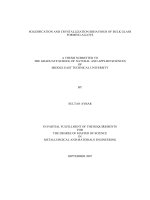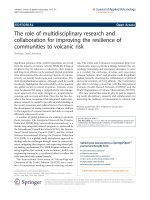Scientific report: Improving English pronunciation of students Hanoi Agricultural University pot
Bạn đang xem bản rút gọn của tài liệu. Xem và tải ngay bản đầy đủ của tài liệu tại đây (144.44 KB, 6 trang )
J. Sci. Dev. 2009, 7 (Eng.Iss.1): 130 - 135 HA NOI UNIVERSITY OF AGRICULTURE
130
Improving students' pronunciation at Hanoi University
of Agriculture
Cải thiện phát âm tiếng Anh của sinh viên trường Đại học Nông nghiệp Hà Nội
Ha Thi Lan
Faculty of Education and Foreign Languages
TÓM TẮT
Bài báo này nhằm mục đích đánh giá thực trạng phát âm tiếng Anh của sinh viên trường Đại học
Nông Nghiệp Hà Nội và gợi ý một số phương pháp cụ thể để cải thiện khả năng phát âm của sinh
viên. Thực tế cho thấy rằng hầu hết sinh viên đều không quan tâm đến phần phát âm từ cho đến khi
họ gặp khó khăn khi nói tiếng Anh chuẩn xác và khó khăn trong khi nghe băng đĩa tiếng Anh. Hơn
nữa, họ chỉ biết bắt chước người khác phát âm mà họ cho rằng người đó nói tiếng Anh giỏi hơn họ.
Tuy nhiên, việc giới thiệu cho sinh viên các ký hiệu phiên âm quốc tế được lồng ghép trong chương
trình giảng dạy tiếng Anh tại trường đã phần nào giúp cho sinh viên biết cách phát âm từ mọt cách
chuẩn xác hơn. Sinh viên có thể nhận biết cách phát âm từ khi tra từ vựng trong từ điển. Hơn thế
nữa, việc giới thiệu cho sinh viên nhận biết trọng âm của từ đã khuyến khích sinh viên chú ý hơn khi
nói tiếng Anh sao cho chuẩn xác.
Từ khóa: Ký hiệu phiên âm, phát âm, trọng âm.
SUMMARY
This article aims at assessing the actual situation about students’ pronunciation at Hanoi
University of Agriculture and recommending some specific methods to improve the students’
pronunciation. It is found that most students have neglected pronunciation until they have difficulties
in speaking pleasant English accurately and listening to English through tapes or CDs. Moreover, they
had to depend on imitating English sounds from the others that are considered to be better English
speakers. However, introducing the International phonetic symbols is included in the syllabus has
helped students pronounce English words accurately to some extent. Students are able to know the
pronunciation of words from dictionaries. Also, word stress has been addressed to students, which
has motivated them to concentrate on speaking pleasant English.
Key words: Phonetic symbols, pronunciation, word stress.
1. INTRODUCTION
Why is proper pronunciation important?
Hence, Gilbert (1995: 1) believed that the skills of
listening comprehension and pronunciation are
interdependent, and contends ‘if they (learners)
cannot hear well, they are cut off from language. If
they (learners) cannot be understood easily, they
are cut off from conversation with native speakers.”
Likewise, Nooteboom (1983) suggested that speech
production is affected by speech perception, and
stresses the need of pronunciation in both listening
and speaking. Wong (1987) points out that even
when the non-native speakers’ vocabulary and
grammar are excellent, if their pronunciation falls
below a certain threshold level, they are unable to
communicate efficiently and effectively.
Observations that limited pronunciation skills can
undermine learners' self-confidence, restrict social
interactions, and negatively influence estimations
of a speaker's credibility and abilities are not new
(Morley, 1998).
Without correct pronunciation- no matter how
vast the student's vocabulary may be, no matter
how well the student understands and uses
grammatical rules, no matter what their level of
Improving students’ pronunciation at Hanoi University of Agriculture
131
reading or writing skills may be- if they don't use
correct pronunciation it may be very difficult for
listeners to understand what they say. And that is a
huge hindrance to communication. In addition,
some research indicates that if a student can not
pronounce a word correctly, they may not be able
to hear it when spoken by another person either,
which furthers hinders communication.
At Hanoi University of Agriculture, most of
the students come from different rural provinces of
the North of Viet Nam, so their English proficiency
is limited. Many semi-structure interviews
conducted during break time have indicated that
they were taught with the traditional grammar –
translation when they were at school. Moreover,
their English proficiency was tested mainly in
grammar and reading. They did not use to practice
listening and speaking in class. Moreover, they
only concentrated getting knowledge of the subjects
of groups A, and B so as to pass the university
entrance exam. As a result, they have a little
knowledge of grammar. They have never paid
attention to the pronunciation of words. They
pronounce words in a wrong way. I often say to
them that they can understand each other when they
make the same mistakes in pronunciation.
However, they will misunderstand each other if
they pronounce words differently. They actually
speak unpleasant English. Therefore, they find the
listening and speaking skills the most difficult
when surveyed. It is a big obstacle for them to
communicate with English native speakers.
This article reviews the current status of
pronunciation in EFL classes at HUA. It provides
an overview of the factors that influence
pronunciation mastery and suggests some ways to
plan and implement pronunciation instruction.
2. FACTORS INFLUENCING
PRONUNCIATION MASTERY
Research has contributed some important data
on factors that can influence the learning and
teaching of pronunciation skills. Celce-Murcia,
Brinton, & Goodwin, (1996), Gillette (1994),
Graham (1994) and Pennington (1994) discussed
the following factors.
"Age". The debate over the impact of age on
language acquisition and specifically pronunciation
is varied. Some researchers argue that, after
puberty, lateralization (the assigning of linguistic
functions to the different brain hemispheres) is
completed, and adults' ability to distinguish and
produce native-like sounds is more limited. Others
refer to the existence of sensitive periods when
various aspects of language acquisition occur, or to
adults' need to re-adjust existing neural networks to
accommodate new sounds. Most researchers,
however, agree that adults find pronunciation more
difficult than children do and that they probably
will not achieve native-like pronunciation. Yet
experiences with language learning and the ability
to self-monitor, which come with age, can offset
these limitations to some degree.
"Amount and type of prior pronunciation
instruction". Prior experiences with such
pronunciation instruction may influence learners'
success with current efforts. Learners at higher
language proficiency levels may have developed
habitual, systematic pronunciation errors that must
be identified and addressed.
"Aptitude". Individual capacity for learning
languages has been debated. Some researchers
believe all learners have the same capacity to learn
a second language because they have learned a first
language. Others assert that the ability to recognize
and internalize foreign sounds may be unequally
developed in different learners.
"Learner attitude and motivation".
Nonlinguistic factors related to an individual's
personality and learning goals can influence
achievement in pronunciation. Attitude toward the
target language, culture, and native speakers;
degree of acculturation (including exposure to and
use of the target language); personal identity issues;
and motivation for learning can all support or
impede pronunciation skills development.
"Native language". Most researchers agree that
the learner's first language influences the
pronunciation of the target language and is a
significant factor in accounting for foreign accents.
So-called interference or negative transfer from the
first language is likely to cause errors in aspiration,
intonation, and rhythm in the target language.
The pronunciation of any one learner might be
affected by a combination of these factors. The key
is to be aware of their existence so that they may be
considered in creating realistic and effective
pronunciation goals and development plans for the
learners. For example, native-like pronunciation is
not likely to be a realistic goal for older learners; a
learner who is a native speaker of a tonal language,
such as Vietnamese, will need assistance with
different pronunciation features than will a native
Spanish speaker; and a twenty-three year old
Ha Thi Lan
132
engineer who knows he will be more respected and
possibly promoted if his pronunciation improves is
likely to be responsive to direct pronunciation
instruction.
3. LANGUAGE FEATURES INVOLVED
IN PRONUNCIATION
Two groups of features are involved in
pronunciation: segmentals and suprasegmentals.
"Segmentals" are the basic inventory of distinctive
sounds and the way that they combine to form a
spoken language. English, for example, has
approximately 44 phonemes. Pronunciation
instruction has often concentrated on the mastery of
segmentals through discrimination and production
of target sounds.
"Suprasegmentals" transcend the level of
individual sound production. They extend across
segmentals and are often produced unconsciously
by native speakers. Since suprasegmental elements
provide crucial context and support (they determine
meaning) for segmental production, they are
assuming a more prominent place in pronunciation
instruction (Celce-Murcia, Brinton, & Goodwin,
1996; Gilbert, 1990; Morley, 1991).
Suprasegmentals include the following:
* Stress a combination of length, loudness,
and pitch applied to syllables in a word (e.g.,
Happy, FOOTball);
* Rhythm the regular, patterned beat of
stressed and unstressed syllables and pauses (e.g.,
with weak syllables in lower case and stressed
syllables in upper case: they WANT to GO Later.);
* Adjustments in connected speech
modifications of sounds within and between words
in streams of speech (e.g., "ask him," /æsk him/
becomes /æs kim/);
* Prominence speaker's act of highlighting
words to emphasize meaning or intent (e.g., Give
me the BLUE one. (not the yellow one); and
* Intonation the rising and falling of voice
pitch across phrases and sentences (e.g., Are you
REAdy?).
4. PRONUNCIATION INSTRUCTION IN
EFL CLASSES AT HUA
Most of the writer’s students have their
English proficiency at low level. They can not
speak English fluently. They have difficulties
producing long sentences with fluency and
accuracy of pronunciation. As an EFL teacher, my
first priority is to help my students develop their
pronunciation skills. Without proper
pronunciation, other aspects of English such
as vocabulary and grammar become useless if a
student cannot be understood when he uses the
language.
When teaching pronunciation, teachers are
giving feedback to their students about how they
are saying things. This feedback includes what the
problem is and what they need to do to correct it.
This feedback may include where to place the
tongue in the mouth to say particular words, or how
the lips should be formed, or the action of the
tongue when saying specific sounds.
Mastering proper pronunciation is not just a
matter of learning individual sounds. Many
students can hear and make the different sounds for
all the vowels and consonants in English.
Unfortunately, they also have to contend with the
sound changes that occur with different letter
combinations resulting from linking or reduction of
vowels and consonants, not to mention stress, pitch,
and intonation differences between their native
tongue and English.
That's basically all there is to teaching
pronunciation- giving feedback and ensuring that
the student uses the feedback to improve their
speaking skills.
Some pronunciation instructions that have
been implemented by the writer in some classes of
course 52 and the class 53 of the advanced
education program of crops science at HUA.
4.1. Introducing phonemic symbols
Phonemic chart was introduced at the
beginning of the Basic English course. The
phonemic symbols represent the sounds of the
English language. Using them can be a valuable
tool to improving your students' pronunciation. The
alphabet which we use to write English has 26
letters but (British) English has 44 sounds.
Inevitably, English spelling is not a reliable guide
to pronunciation because some letters have more
than one sound. Also, letters are sometimes not
pronounced at all. Moreover, the same sound may
be represented by different letters. Especially,
sometimes syllables indicated by the spelling are
not pronounced at all.
Here is a list of core items which were taught
to the writer’s students. Firstly, explanation of
Improving students’ pronunciation at Hanoi University of Agriculture
133
manner of articulation and place of articulation was
introduced to the students. To illustrate this more
clearly, the writer posted the picture of the
articulators on the power point. Secondly, voiced
and unvoiced sounds were presented in pairs so that
the students could compare the sounds. Students
should be taught this to help with the pronunciation
of ‘s’ and ‘ed’ endings. Thirdly, discrimination of
sounds in English and in Vietnamese is very
important to help the students make effort when
pronouncing difficult sounds that are different from
some Vietnamese sounds. Fourthly, long and short
vowels are emphasized. The students need to be
able to confidently differentiate and produce these
as they are both challenging and have an effect on
meaning. Fifthly, word final consonants were
introduced to the students. Vietnamese students
often neglect these and constant exercises on final
endings should be done attentively during any
course. Finally, consonant clusters were addressed
to the students. These are not a feature of
Vietnamese and therefore are challenging. ‘sts’,
‘ts’, ‘str’, and ‘tr’ appear to be the most challenging
for many students.
All the phonemic symbols were pronounced
carefully and clearly by the writer and repeated by
the students. Then the writer posted some words
with their transcriptions so that the students could
pronounce the words by themselves. Their
pronunciation was checked by the writer.
4.2. Introducing word stress
Raise Awareness
The writer has asked the students the
questions: What is word stress? Why is word stress
important? to build their awareness.
They are interested to learn about syllables,
silent letters and stress, and it has built their
confidence in English to know why words are
pronounced in a certain way.
Here are some details at a possible ‘recipe’ the
writer has used for teaching word stress.
Firstly, the writers started with two syllable
words, and try to choose words with simple
phonemes that are not likely to distract students’
attention or undermine their confidence.
Secondly, the students were asked to identify
the stressed syllable from your pronunciation of the
word. Thirdly, the words were written on the board,
and the students were asked to copy them into their
books. Then they said the word several times and
they were asked to underline the stressed syllable.
Fourthly, the stressed syllable was underlined on
the board and checks their answers. Fifthly, the
teacher discussed any errors, and then asked the
students, all together then one at a time, to repeat
the words back to you. In judging their production,
the teacher focused on stress pattern rather than
phonemes, but did correct any glaring phoneme
errors.
Finally, the teacher should comment
throughout on the fact that one of the syllables of
each word is louder than the other. It is true that
stressed syllables are also usually longer and at
higher pitch than other syllables, but getting into
that can confuse students, because we also talk
about length in relation to vowel length, and about
pitch in relation to intonation. So the teacher should
use these concepts with caution.
Showing the stress
The writer has established a clear way of
showing my students word stress, and to be
consistent in using it. A good way of showing stress
is to use small and big circles above the word. Use
a clear easy-to-see way of marking stress on the
board and on handouts for students. I use the big
circle - small circle (O o) method. It is very easy to
see and has the added advantage of identifying the
number of syllables in the word, as well as the
stressed syllable.
Students also need to be aware of the way
dictionaries usually mark stress - with a mark
before the stressed syllable, e.g. 'apple. By knowing
this, students will be able to check word stress
independently. This is good because you can show
the number of syllables as well as the stressed one.
It’s important to tell the students that stress is
shown in different ways in dictionaries. Often the
stressed syllable is preceded with an apostrophe
(e.g. ‘teacher). Encourage students to record the
stress in words as well as their meaning in their
notebooks.
Integrating
The most successful way to teach good
pronunciation is to integrate it into every lesson.
Encourage students to be as curious about the
pronunciation of a word as they are about the
meaning. Drill the pronunciation and stress. The
more students are engaged in a word, the more
likely they are to remember it. In short,
Pronunciation teaching should be systematic,
gradual, consistent, interesting, practical, and
integrated.
Ha Thi Lan
134
Here are some tips the writer would like to
share when teaching pronunciation to your EFL
students:
–Never be shy to correct your students’
pronunciation in class. Wait until the student has
completed the thought and then ask the class to
repeat words that you think were not pronounced
properly. Never interrupt a student in mid
sentence.
–When you are teaching an ESL class about a
particular topic, always spend at least 10 minutes
teaching the pronunciation of new vocabulary
words to students. As they use the vocabulary
words, correct pronunciation as necessary.
–Use fun methods to teach pronunciation. One
such method is by using a stick (or some kind of
pointer) to point at each word. When you point, the
students should repeat the word. If you don’t point,
there should be complete silence. There will always
be a student or two who will still say the word after
you have pointed three or four times and suddenly
stop. You can make a competition to see who is
paying attention. Divide the classroom into five
teams and give each team pictures of the
vocabulary words or actual objects if they are
available. When you call a word, the team that is
responsible for that word should stand up and say
the word in unison. As the game progresses, you
can try to trick the teams by saying a vocabulary
word but pointing at a team that is not responsible
for the word. You can grade each team (using stars
on the board) based on how every team member
reacts, loudness, and togetherness.
–Always focus both on the group and
individuals when practicing pronunciation. Having
the group look at the transcriptions of words and
repeat after you at the same is helpful, but it is also
important to have individual students repeat after
you to make sure that bad pronunciation does not
get hidden in the group.
–Never allow your students to laugh at one
another during pronunciation practice. Being
laughed at can seriously damages a student’s
inspiration to want to learn English. It is important
to promote an environment were students can feel
very comfortable with speaking out loud in class.
–If your students are having trouble with a
particular word or sound, ask them to watch
your mouth as you repeat the word. They can
attempt to imitate the shape of your mouth which
will help improve their pronunciation.
Most importantly, always make sure that you
are speaking slowly and clearly. No matter what
you are teaching, remember that your students are
always listening to you so you need to make sure
that your English is standard and understandable.
Hopefully, you can help your students to
understand the importance of pronunciation in ESL
class so that they will be inspired to work on
pronunciation by themselves.
5. CONCLUSION
Pronunciation is very important to successful
spoken communication. Pronunciation can be one
of the most difficult parts of a language for adult
learners to master and one of the least favourite
topics for teachers to address in the classroom.
Nevertheless, with careful preparation and
integration, pronunciation can play an important
role in supporting learners' overall communicative
power.
The writer herself is really interested in
teaching pronunciation to students. Also, it was
found that most of the students like to be
introduced pronunciation. The students taught the
phonemic chart and word stress have been more
conscious when pronouncing words. Moreover,
they have known how to use dictionaries
effectively. They look at the transcriptions to
pronounce words accurately by themselves. As a
result, they are more confident in speaking English
with their teacher and their friends. This has made
the writer satisfied with her effort because some of
the students have improved their pronunciation.
Hopefully, the students will be able to
communicate in English more confidently after
graduation from university.
REFERENCES
Celce-Murcia, M., Brinton, D., & Goodwin, J.
(1996). "Teaching pronunciation: Reference for
teachers of English to speakers of other
languages." Cambridge: Cambridge University
Press.
Gilbert, J. (1990). "Pronunciation: What should we
be teaching?" (ED 320 443).
Gilbert, J. (1995). Pronunciation practices as an aid
to listening comprehension. In D. J. Mendelson
and J. Rubin (Eds.), A Guide for the Teaching of
Second Language Learning (pp. 97-111). San
Diego: Dominic Press.
Improving students’ pronunciation at Hanoi University of Agriculture
135
Gillette, G. (1994). "On speaking terms: Practical
guide to pronunciation for ABLE/ESL teachers."
Euclid, OH: Northeast ABLE Resource Center.
(ED 393 323).
Graham, J. (1994). Four strategies to improve the
speech of adult learners. "TESOL Journal," 3
(3), 26-28.
Jordan, J. (1992). "Helping ESOL students to
improve their pronunciation." London: Adult
Literacy and Basic Skills Unit. (ED 359 837)
Morley, J. (1998). Trippingly on the tongue:
Putting serious speech/pronunciation instruction
back in the TESOL equation. "ESL Magazine,"
January/February, 20-23.
Morley, J. (1991). Pronunciation component in
teaching English to speakers of other languages.
"TESOL Quarterly," 25 (3), 481-520.
Nooteboom, S. (1983). Is speech production
controlled by speech perception? In van den
Broecke et al. (Eds.), Sound Structure (pp. 153-
194). Dordrecht: Foris.
Pennington, M. (1994). Recent research in L2
phonology: Implications for practice. In: J.
Morley, (Ed.) "Pronunciation pedagogy and
theory. New views, new directions." pp. 92-108.
Alexandria, VA: Teachers of English to Speakers
of Other Languages. (ED 388 061).
Wong, R. (1987). Teaching Pronunciation: Focus
on English Rhythm and Intonation. Englewood
Cliffs, NJ: Prentice Hall Regents.









